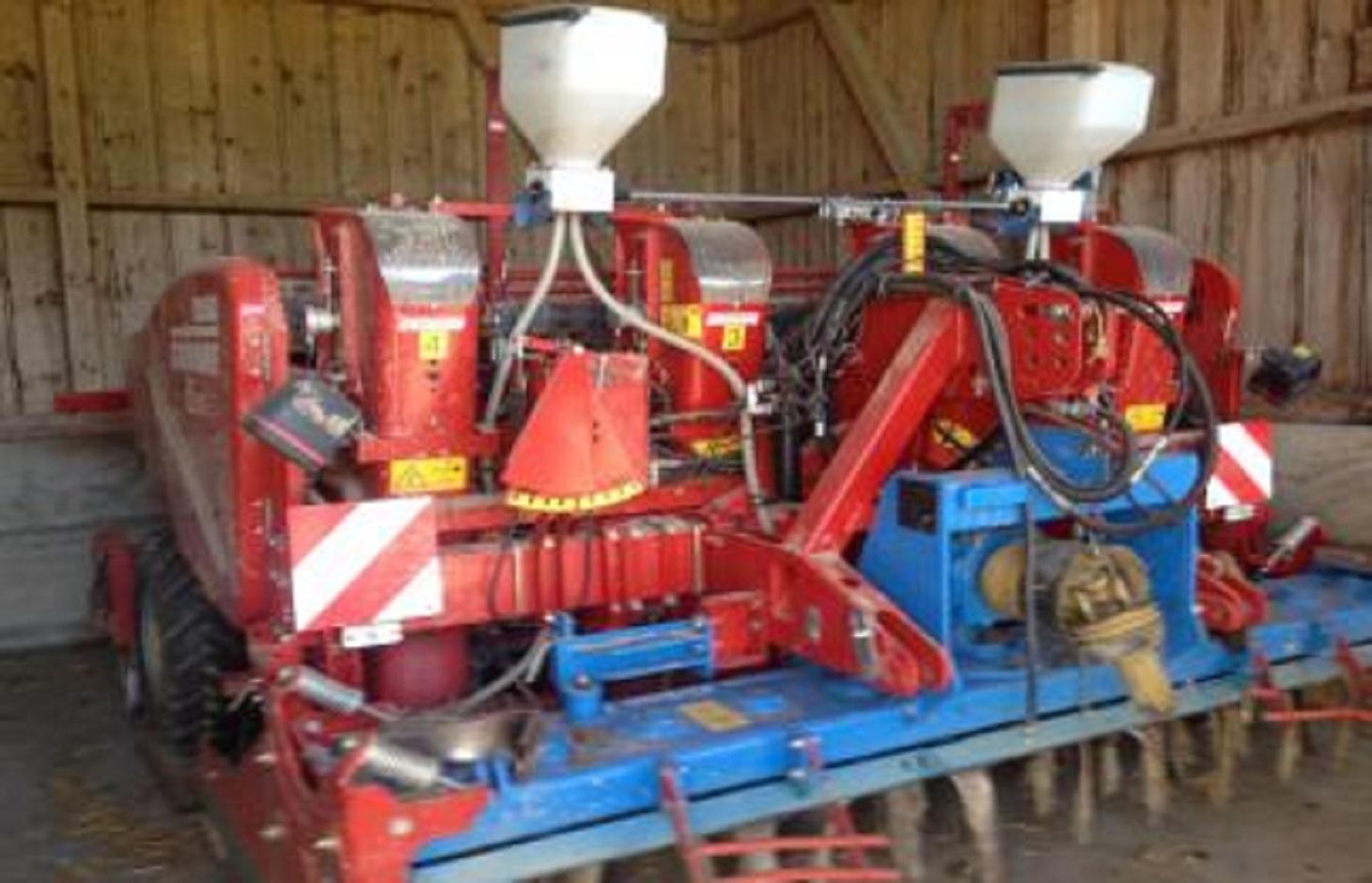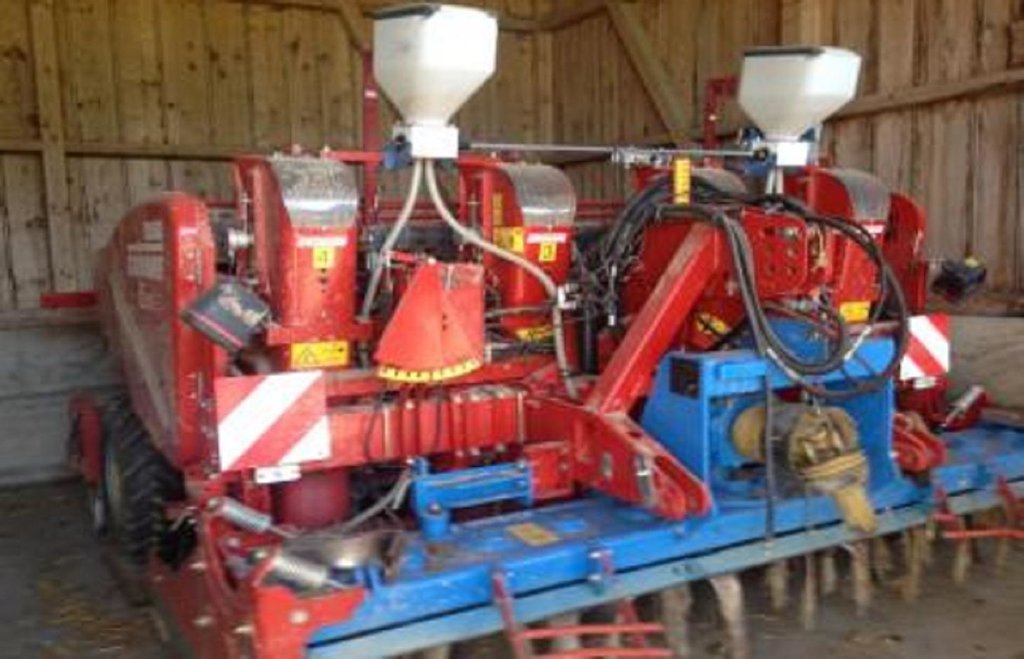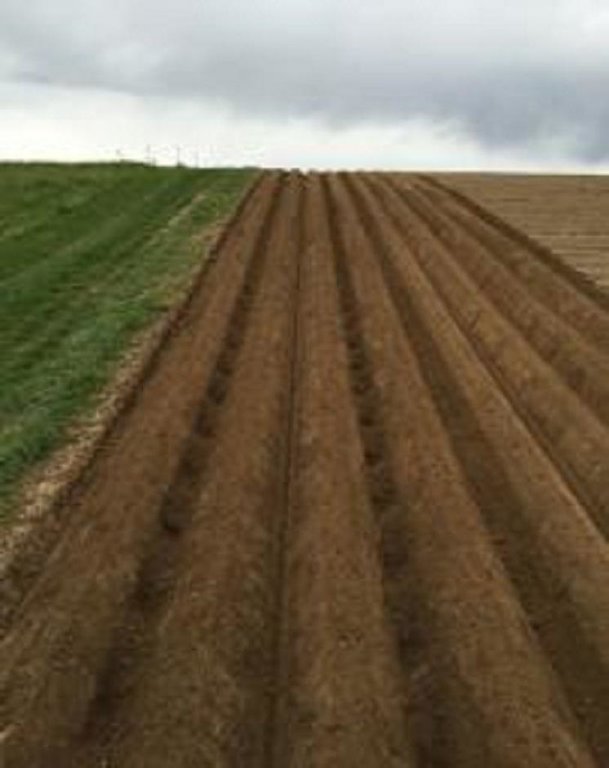Dyker System [瑞士]
- 创建:
- 更新:
- 编制者: Deborah Niggli
- 编辑者: –
- 审查者: Fabian Ottiger
Dyker System im Kartoffelanbau
technologies_1304 - 瑞士
查看章节
全部展开 全部收起1. 一般信息
1.2 参与该技术评估和文件编制的资源人员和机构的联系方式
有助于对技术进行记录/评估的项目名称(如相关)
Preventing and Remediating degradation of soils in Europe through Land Care (EU-RECARE )有助于对技术进行记录/评估的机构名称(如相关)
CDE Centre for Development and Environment (CDE Centre for Development and Environment) - 瑞士1.3 关于使用通过WOCAT记录的数据的条件
(现场)数据是什么时候汇编的?:
27/08/2015
编制者和关键资源人员接受有关使用通过WOCAT记录数据的条件。:
是
2. SLM技术的说明
2.1 技术简介
技术定义:
The Dyker system consists of a special trailer which enables a soil conserving way of cultivating potatoes by building dykes in-between the lanes.
2.2 技术的详细说明
说明:
The Dyker system consists of a new tractor trailer for cultivating potatoes. It is only available as a proto type in Switzerland and was established by Grimme from Germany. With this new technology the normal dams for potatoes are built but also small dams in-between the normal dams. The small dams can prevent soil erosion and financial losses during a heavy rainfall event and are therefore a new soil conservation method.
Purpose of the Technology: The aim of this technology is to prevent soil erosion by water on the field. Water flowing down the slope of a field can be stopped at the small dams and infiltrates through a hole in front of the small dam. The construction of the dams inbetween does not take another working step but can be done simultaneously to the normal dam building. This saves time and money. The special trailer portrayed here is the only one in Switzerland and is currently being tested before getting to the market.
Establishment / maintenance activities and inputs: For the Dyker system only the new tractor trailer is needed in addition to the common tractor and the potatoe machine. At the moment this trailer is not yet for sale and there is only one proto type for testing in whole Switzerland. After the test period Grimme enterprise will decide about the production and commercialization of the Dyker system.
Natural / human environment: The system is intended to prevent soil erosion during the cultivation process of potatoes. Dams running parallel to the gradient are mostly endangered by soil erosion during the first 4-8 weeks. Small dams in-between shall slow down runoff and help infiltrating the water into the soil and thereby protect the soil.
2.3 技术照片
2.5 已应用该技术的、本评估所涵盖的国家/地区/地点
国家:
瑞士
区域/州/省:
Wiler bei Seedorf
有关地点的进一步说明:
Bern
2.6 实施日期
如果不知道确切的年份,请说明大概的日期:
- 不到10年前(最近)
2.7 技术介绍
- request by Grimme enterprise to test the Dyker system
3. SLM技术的分类
3.2 应用该技术的当前土地利用类型

农田
- 一年一作
注释:
Major land use problems (land users’ perception): The major land use problem is soil erosion by water occuring mainly at hillside situations. Land use problems related to the use of the plow are only minor because most of the land users have shifted to direct seeding, mulching or strip tillage.
3.4 该技术所属的SLM组
- 横坡措施
3.5 技术传播
具体说明该技术的分布:
- 均匀地分布在一个区域
如果该技术均匀地分布在一个区域上,请注明覆盖的大致区域。:
- < 0.1 平方千米(10 公顷)
3.6 包含该技术的可持续土地管理措施

农艺措施
- A3:土壤表面处理
- A4:地表下处理
注释:
Main measures: agronomic measures
Type of agronomic measures: zero tillage / no-till
3.7 该技术强调的主要土地退化类型

土壤水蚀
- Wt:表土流失/地表侵蚀
注释:
Main type of degradation addressed: Wt: loss of topsoil / surface erosion
3.8 防止、减少或恢复土地退化
具体数量名该技术与土地退化有关的目标:
- 防止土地退化
注释:
Main goals: prevention of land degradation
4. 技术规范、实施活动、投入和成本
4.2 技术规范/技术图纸说明
Technical knowledge required for field staff / advisors: moderate
Technical knowledge required for land users: high
Main technical functions: control of concentrated runoff: retain / trap, control of concentrated runoff: impede / retard, control of concentrated runoff: drain / divert
Secondary technical functions: reduction of slope length, increase of infiltration
4.3 有关投入和成本计算的一般信息
其它/国家货币(具体说明):
CHF
注明美元与当地货币的汇率(如相关):1美元=:
1.0
4.4 技术建立活动
| 活动 | 措施类型 | 时间 | |
|---|---|---|---|
| 1. | Dyker system usage during cultivation of potatoes | 农业学的 |
4.5 技术建立所需要的费用和投入
| 对投入进行具体说明 | 单位 | 数量 | 单位成本 | 每项投入的总成本 | 土地使用者承担的成本% | |
|---|---|---|---|---|---|---|
| 劳动力 | Labour | ha | 1.0 | 750.0 | 750.0 | 50.0 |
| 植物材料 | Seeds | ha | 1.0 | 3450.0 | 3450.0 | |
| 肥料和杀菌剂 | Fertilizer | ha | 1.0 | 1400.0 | 1400.0 | |
| 技术建立所需总成本 | 5600.0 | |||||
4.7 维护/经常性活动所需要的费用和投入(每年)
注释:
The costs were calculated for the current situation of the land user where he is testing the Dyker system for free. He only has to pay for the labour, the seeds and fertilizer have to be paid by the land users he applies the technology (as a contractor).
4.8 影响成本的最重要因素
描述影响成本的最决定性因素:
The Dyker system is being tested for free at the moment. But machine costs will later affect the total costs most determinately.
5. 自然和人文环境
5.1 气候
年降雨量
- < 250毫米
- 251-500毫米
- 501-750毫米
- 751-1,000毫米
- 1,001-1,500毫米
- 1,501-2,000毫米
- 2,001-3,000毫米
- 3,001-4,000毫米
- > 4,000毫米
农业气候带
- 半湿润
Thermal climate class: temperate
5.2 地形
平均坡度:
- 水平(0-2%)
- 缓降(3-5%)
- 平缓(6-10%)
- 滚坡(11-15%)
- 崎岖(16-30%)
- 陡峭(31-60%)
- 非常陡峭(>60%)
地形:
- 高原/平原
- 山脊
- 山坡
- 山地斜坡
- 麓坡
- 谷底
垂直分布带:
- 0-100 m a.s.l.
- 101-500 m a.s.l.
- 501-1,000 m a.s.l.
- 1,001-1,500 m a.s.l.
- 1,501-2,000 m a.s.l.
- 2,001-2,500 m a.s.l.
- 2,501-3,000 m a.s.l.
- 3,001-4,000 m a.s.l.
- > 4,000 m a.s.l.
5.3 土壤
平均土层深度:
- 非常浅(0-20厘米)
- 浅(21-50厘米)
- 中等深度(51-80厘米)
- 深(81-120厘米)
- 非常深(> 120厘米)
土壤质地(表土):
- 中粒(壤土、粉土)
表土有机质:
- 中(1-3%)
5.4 水资源可用性和质量
地下水位表:
5-50米
地表水的可用性:
好
水质(未处理):
良好饮用水
5.5 生物多样性
物种多样性:
- 高
5.6 应用该技术的土地使用者的特征
生产系统的市场定位:
- 商业/市场
非农收入:
- 收入的10-50%
相对财富水平:
- 丰富
个人或集体:
- 个人/家庭
机械化水平:
- 机械化/电动
性别:
- 男人
说明土地使用者的其他有关特征:
Land users applying the Technology are mainly Leaders / privileged
5.7 应用该技术的土地使用者拥有或租用的平均土地面积
- < 0.5 公顷
- 0.5-1 公顷
- 1-2 公顷
- 2-5公顷
- 5-15公顷
- 15-50公顷
- 50-100公顷
- 100-500公顷
- 500-1,000公顷
- 1,000-10,000公顷
- > 10,000公顷
这被认为是小规模、中规模还是大规模的(参照当地实际情况)?:
- 中等规模的
5.8 土地所有权、土地使用权和水使用权
土地所有权:
- 个人,有命名
土地使用权:
- 个人
用水权:
- 个人
5.9 进入服务和基础设施的通道
健康:
- 贫瘠
- 适度的
- 好
教育:
- 贫瘠
- 适度的
- 好
技术援助:
- 贫瘠
- 适度的
- 好
就业(例如非农):
- 贫瘠
- 适度的
- 好
市场:
- 贫瘠
- 适度的
- 好
能源:
- 贫瘠
- 适度的
- 好
道路和交通:
- 贫瘠
- 适度的
- 好
饮用水和卫生设施:
- 贫瘠
- 适度的
- 好
金融服务:
- 贫瘠
- 适度的
- 好
6. 影响和结论性说明
6.1 该技术的现场影响
社会经济效应
生产
生产故障风险
收入和成本
工作量
社会文化影响
SLM/土地退化知识
生态影响
水循环/径流
地表径流
土壤
土壤流失
土壤结壳/密封
土壤压实
其它生态影响
Hazard towards adverse events
6.2 该技术的场外影响已经显现
下游洪水
对邻近农田的破坏
6.3 技术对渐变气候以及与气候相关的极端情况/灾害的暴露和敏感性(土地使用者认为的极端情况/灾害)
渐变气候
渐变气候
| 季节 | 气候变化/极端天气的类型 | 该技术是如何应对的? | |
|---|---|---|---|
| 年温度 | 增加 | 好 |
气候有关的极端情况(灾害)
气象灾害
| 该技术是如何应对的? | |
|---|---|
| 局地暴雨 | 不好 |
水文灾害
| 该技术是如何应对的? | |
|---|---|
| 比较和缓的(河道)洪水 | 不好 |
6.4 成本效益分析
技术收益与技术建立成本相比如何(从土地使用者的角度看)?
短期回报:
稍微积极
长期回报:
积极
6.5 技术采用
注释:
There is a moderate trend towards spontaneous adoption of the Technology
Comments on adoption trend: A trend towards spontaneous adoption is there but the Dyker system is not yet on the market.
6.7 该技术的优点/长处/机会
| 土地使用者眼中的长处/优势/机会 |
|---|
| The small dams in-between the normal dams enhance infiltration of the soil and stop runoff. |
| 编制者或其他关键资源人员认为的长处/优势/机会 |
|---|
|
The problematic crop of potatoes can be prevented from soil erosion thanks to the Dyker system. How can they be sustained / enhanced? The system has to be on the market soon and to be sold at an appropriate price. |
6.8 技术的弱点/缺点/风险及其克服方法
| 土地使用者认为的弱点/缺点/风险 | 如何克服它们? |
|---|---|
| The overhang of the machine when turning around requires high knowledge and time. | Good technical skills and experience with big, heavy machines are necessary to use the Dyker system correctly so that it is a soil conservating method. |
| Costs for the Dyker system are not yet published. They should not exceed USD 5000-6000$. | Costs should not go beyond the financial possibilities of a land user in order to support a great adoption of the system. |
| 编制者或其他关键资源人员认为的弱点/缺点/风险 | 如何克服它们? |
|---|---|
| The additional weight of the trailer could lead to soil compaction. | Divide the weight equally, adapt tire pressure in order to minimize damage to the topsoil layer. |
链接和模块
全部展开 全部收起链接
无链接
模块
无模块




